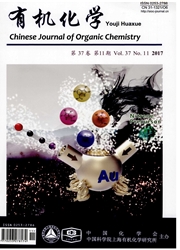

 中文摘要:
中文摘要:
酰胺和芳腈结构广泛存在于天然产物、农药和医药分子中.传统的合成方法一般需要采用活化的羧酸及其衍生物或剧毒的氰化物作为原料.在我们前期铜催化C—CN键断裂以及C—N偶联的工作基础上,参考了碘苯与苯乙腈发生的氰基化反应以及苯乙腈与N,N-二甲基甲酰胺(DMF)发生的酰胺化反应,以Cu_2O为催化剂,邻菲啰啉为配体,氧气为氧化剂,采用苯乙腈、DMF、碘苯为反应物,“一锅法”同时进行酰胺化反应和氰基化反应,生成相应的目标产物N,N-二甲基苯甲酰胺和苯腈,产率分别可达到85%和75%.
 英文摘要:
英文摘要:
Amide is one of the most important functional groups in nature. Besides the classical synthetic method by using activated acid with amine, several other transition metal-catalyzed protocols have been developed. Aryl nitriles have also at- tracted substantial attentions as herbicides, natural products, etc. Traditional methods towards aryl nitriles include Sandmeyer and Rosenmund von Braun reaction. In addition of these methods, researchers have explored various kinds of toxic "CN" sources. In continuation of our previous work on copper catalyzed C--CN bond cleavage and C--N formation reactions, herein our recent work of combination of copper-catalyzed amidation of benzyl cyanide and cyanation of aryl iodides by using N,N-dimethyl formamide (DMF) as amide source is reported. A representative procedure for this reaction is as following: ben- zyl cyanide (1 mmol), iodobenzene (1 mmol), DMF (2 mL), TsOH (1 mmol), Cu20 (0.2 mmol), 1,10-phenanthroline (0.4 mmol) were added into a 10 mL of Schlenk tube. The mixture was stirred at 130 ~C under 02 atmosphere for 12 h. The reac- tion mixture was then cooled down to room temperature, quenched with water, and extracted with ethyl acetate. The organic layer was then dried over anhydrous MgSO4, and the solvent was removed in vacuo. The residue was finally purified by col- umn chromatography on silica gel using petroleum ether-ethyl acetate mixture as eluent. A variety ofN, N-dimethyl benzamides and benzonitriles were obtained in yields up to 85% and 75%, respectively.
 同期刊论文项目
同期刊论文项目
 同项目期刊论文
同项目期刊论文
 期刊信息
期刊信息
